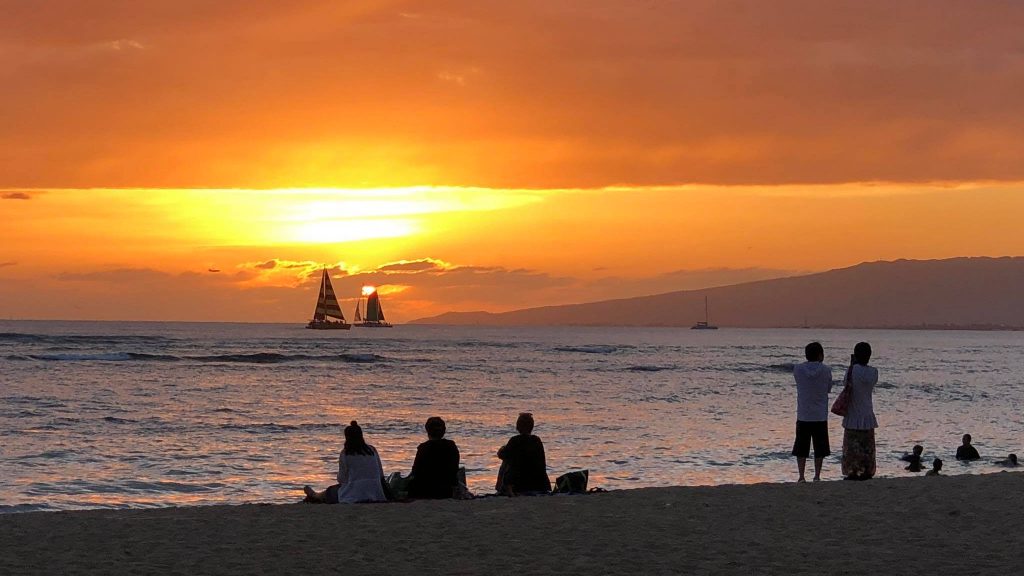The annual Association for Research in Vision and Ophthalmology (ARVO) conference moved off mainland America to Hawaii for the first time in May 2018, which I'm sure helped to boost attendance and was a much shorter travel time for us Australasians. With over 10,000 attendees and thousands of research posters, papers and symposiums presented over 5 days, it was a mind blowing nerdy extravaganza. Here are a bunch of cutting edge research pieces which I posted to the Myopia Profile Facebook group at the time. I've decided to accompany them with beautiful Hawaiian sunset photos I took during our visit.
1 - Sub-foveal choroidal thickness predicting myopia?
Sub-foveal choroidal thickness (SFCT) measurement is the new topic du jour in myopia - short term application of treatments can be measured as short term changes in SFCT which, it’s presumed, we could use to test efficacy. So could we measure SFCT in children to predict future myopia? No, according to the Copenhagen Child Cohort (CCC2000) study, which examined 741 kids born in the year 2000, at age 11 and 16. Five year axial growth was median 0.25mm, with myopes growing twice as much. We’re still learning about how much axial length growth is normal in childhood, per year, as part of the emmetropization process - a paper by Don Mutti at IMC 2017 concluded around 0.1mm per year is normal, more in younger kids and less in older kids - so this shows much less than the 0.1mm / year in an older group. I explain this further in the blog How Myopic Dioptres are like IOP. The authors measured SFCT but found no association between a thinner choroid at age 11 and onset of myopia by age 16, once adjusted for axial length. Discussions around ARVO have included that separation of the data into those who became myopic and those who stayed emmetropic, instead of averages, may have revealed relationships.
What was clear is that a longer axial length at age 11 is a clear risk factor for future myopia. What the ‘cut point’ would be for risk is yet to be determined - my ‘clinical dream’ from this paper was that in future we’ll have a magic number for axial length, or combination of factors, which could help us predict future myopia. Abstract here.
2 - Diurnal rhythms in myopes and emmetropes
Ocular and systemic diurnal rhythms in emmetropes and myopes - is there any difference? Adults wore light, sleep and activity monitors over 24 hours and diurnal variations in choroidal thickness, axial length, IOP, blood pressure (the last two used to calculate mean ocular perfusion pressure) and saliva cortisol and melatonin were measured every 4 hours. Results showed there were no differences in amplitudes of the diurnal rhythms between refractive groups (for details see abstract below), but one comment the author made in the presentation was that myopes showed higher melatonin levels at midnight and 4am, in antiphase (with lower levels) of cortisol. So I’m thinking... does this mean us adult myopes are better sleepers? Less stressed? Apparently not in myopic children - the author referenced a fascinating 2016 study I subsequently read, which showed a relationship between less sleep and higher odds of myopia in over 3600 Korean children aged 12-19 years. More than 9 hours a night reduces risk. Get those kiddies to bed... unsure of the conclusion for myopic adults! Abstract here.
3 - Kids and screens
How closely are kids actually holding these screens? Children under 8 spend an average of 2.3 hours per day on screens and the average daily time has tripled since 2013. Researchers from Spain (Mateusz Tomasz Jaskulski, Yuou Liu & Norberto Lopez-Gil) have developed an Android app to measure working distance and face illumination level from personal mobile devices. The app showed excellent reliability, but what really caught my eye on the poster was measurements they had undertaken on children, showing that per hour spent on a screen, almost half is spent looking at a 15-20cm working distance and the majority involves looking closer than 30cm. Aside from the binocular vision demands, research from QUT last year showed that only short term viewing of a 6D target (17cm) showed a significant increase in axial length in myopes. Be afraid of those screens... be very afraid! Reminding every child of the Harmon distance, especially myopic kids, is essential. Abstract here.

About Kate
Dr Kate Gifford is a clinical optometrist, researcher, peer educator and professional leader from Brisbane, Australia, and a co-founder of Myopia Profile.












